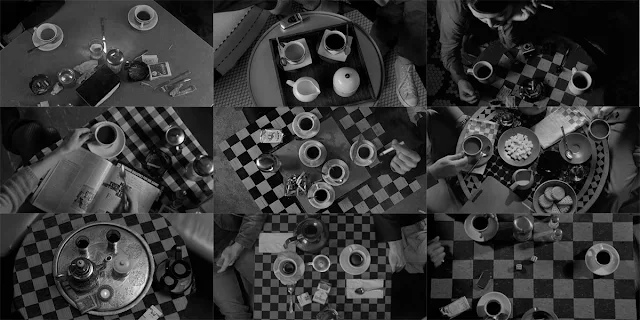 |
| Gena Rowlands and Winona Ryder in Night on Earth |
 |
| Armin Mueller-Stahl and Giancarlo Esposito in Night on Earth |
 |
| Béatrice Dalle and Isaach De Bankolé in Night on Earth |
 |
| Paolo Bonicelli and Roberto Benigni in Night on Earth |
 |
| Matti Pellonpäá in Night on Earth |
Corky: Winona Ryder
Helmut Grokenberger: Armin Mueller-Stahl
YoYo: Giancarlo Esposito
Angela: Rosie Perez
Paris Cab Driver: Isaach De Bankolé
Blind Woman: Béatrice Dalle
Rome Cab Driver: Roberto Benigni
Priest: Paolo Bonacelli
Mika: Matti Pellonpää
Man No. 1: Kari Väänänen
Man No. 2: Sakari Kuosmanen
Man No. 3: Tomi Salmela
Director: Jim Jarmusch
Screenplay: Jim Jarmusch
Cinematography: Frederick Elmes
Film editing: Jay Rabinowitz
Music: Tom Waits
I guess people don't smoke in taxis anymore -- at least in tobacco-hostile America -- so Jim Jarmusch's Night on Earth probably evokes a kind of nostalgie de la boue in smokers or ex-smokers. Everyone lights up in the five segments of the movie, although Los Angeles resident Victoria Snelling at least chides her driver, Corky, for indulging the habit -- only to light up her own after Corky sarcastically refers to her as "Ma." Perhaps Victoria's advice crosses some kind of line between passenger and cabbie. In Rome, it will be the cabbie who crosses the line, persuading his priest-passenger to hear his taxicab confession, an experience that will bring about the priest's demise. In New York, passenger YoYo even becomes the cabbie, taking over the wheel from the incompetent driver, new immigrant Helmut Grokenberger. At least in Paris and Helsinki the old conventions remain, although Isaach De Bankolé's driver is infuriated at the liberties some of his passengers take with him, especially the well-to-do Africans who taunt him for his lowly Côte d'Ivoire origins. In Helskini there's a kind of working-class solidarity between Mika and his drunken passengers, one of whom has not only just been fired but has also learned that his daughter is pregnant and his wife has left him. What do all of these slices of life add up to? That's one of the charms of reflecting on an anthology film like Night on Earth, in which discrete segments seem to echo and enlarge one another. One of the reasons that taxicabs are so effective a setting for movies is that they can become crucibles for temporary relationships, moments out of time and space that seem more freighted with meaning than they really are -- Roberto Benigni's cabbie makes the resemblance of taxi to confessional booth part of his appeal to the priest. Put together five such moments, in five distinct cities, and you have something that looks like a statement about our common humanity. Although each segment neatly evokes the character of its particular city -- the glitz of LA, the grubby hopefulness of New York, the weary cosmopolitanism of Paris, the religion-steeped past and skeptical present of Rome, the chilly Cold War-haunted between-two-worlds quality of Helsinki -- the space and time inside their taxicabs seems oddly universal. That's what I love about Jarmusch's movies: Long after you've watched them, you're still savoring the details while bemused about the whole.

_poster.jpg)